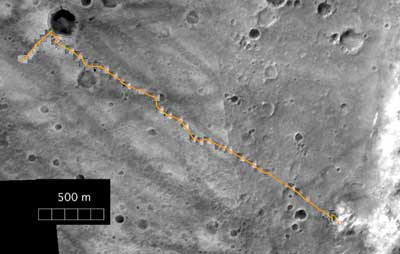It was that same dream again.

Feeling like I was submerged in heavy orange liquid wind, blowing over me like a hurricane.
I am falling downward into a huge pool, but then when I hit the water and become bouyant, I notice that I can't breathe. I try breathing for a few minutes, but it's as if my lungs wont expand, like they're not even there at all.
After a while I give up, give in to the strange swirling lake that I'm in, and I forget about the breathing and just keep swimming. I go deeper and deeper since I'm not concerned about the snorkel every getting filled again, nor do I worry about having a tank at my back. I don't even worry about whether I might get the bends.
I swim swiftly, going deeper. I can't quite look back and see my feet, possibley because of these bulky fishtank goggles that I'm wearing but I know by my pace that I must have powerful fins on.
Then I see something dark in the orange-red water. It's like a disc with a square box on top of it. Head-on it looks like an old twentieth century top hat, and I half expect Woodrow Wilson looking up from under it as I get closer.
As I get closer, it brightens to a grayish hue, and starts propelling itself to me, and I see a yellow trail behind it. It comes straight at me and then turns to my right just at the last instant, and swims off, but I see it's dropped something, or thrown it at its speed, and I raise my hand too slowly to catch it.
The dream always ends right there. Sometimes in the past I would wake up, sweating, but I've had this dream or several almost just like it and so I am less frightened this time. I stay in bed, feigning sleep at least until the primary alarm buzzer goes off.
I head in to the office that morning, it's nice not to be travelling this month. I know where I'm going to be today and there's less unknowns in my environment. While I usually enjoy the adventure of travelling that I get with my job, I don't like dealing with the trivial problems that occur.
You'd think, if they can put a family on Mars, that they could get your luggage to it's destination. Of course I realize that the problem with that expectation is that you are dealing with several "theys". Though the national space programs worked throughout the last decade to put a person on Mars, they all failed. Finally the President of the United States gave their program an ultimatum and they had to put not just an individual adult, but a complete family on Mars.
The proposal had its effect: those working the Mars initiative started to take their testing more seriously. It's not really that their own tests failed, its that there weren't the inter-device tests that the probes, landers, and even re-entry capsules needed to work properly. Because the components were all designed via different technologies, materials, programmed with different computer systems, and designed to fulfill exact requirements specified by the bid process. The systems were required to do certain things, but the selection and completion approval process, never took into account the device interactions. Therefore the failures continued to be at the boundaries, not inside the components.
Because of the moral stakes if the whole family, including children and pet dog were to die, they made sure it would work. My great-grandfather worked on some of the early Mars missions. He was the solar system division director in Washington D.C., when the Mars missions were first extended for another 5 months, then another 12 months, when the rovers appeared to have outlived their fated demise.
Both of those rovers ended up toppling over cliffs when they each were given instructions to keep driving for far too long right before they reached radio silence because of solar interference. The lander named Spirit ended up falling into a crevice in the highlands called the "Columbia Hills," Opportunity was just inside a stadium-size "Endurance Crater," before it was told to climb up and edge flipping it over on its back and rolling down into the center of the crater. Each of them continued to transmit until their battery power wore down, their useless solar panels covered with dirt and dust.
NASA finally got what it needed when it brought its fix-it engineers into the design group from the start of a project. These people really knew their fault tolerant system design and were capable of bringing that to the forefront.